Although technically this should be our ‘Mushroom Monday’ post, Leocarpus fragilis is not actually a fungus. However, while out hunting for mushrooms, it really caught my eye, and thought it worth a mention.
Leocarpus fragilis is a slime mold. Slime molds were historically classified as fungi, but today they belong to the class of true slime molds, Myxomycetes. As soon as the clouds parted after last week’s heavy rain, this slime mold seemed to be everywhere.
Leocarpus fragilis is found worldwide, and typically inhabits shady, cool, moist areas, growing on decaying leaves and logs.
In this phase Leocarpus fragilis is very easy to see, and from a distance almost looks like egg yolk spilled on decaying logs and leaves.
When the plasmodium exhausts the available nutrients in the presence of visible light, it differentiates into specialized fruiting bodies, called sporangia, where spores are formed. These fruiting bodies eventually rupture, releasing the spores into the environment.
In this phase Leocarpus fragilis may be mistaken for clusters of insect eggs, and this species of slime mold is commonly referred to as the ‘Insect-Egg Slime Mold’.
When the fruiting bodies first appear, they are bright orange and impossible to miss, but this stage is short lived. Within 24 hours they age and take on the same dull brown color of the decaying leaves and logs, and can be difficult to spot.
Unlike some of the fungi we’ve seen, slime molds do not seem particularly fussy about substrate. Within just a few feet, I found it growing on the decaying leaves of California Big Leaf Maple, Redwood, and Oak, and even amidst the moss on the north side of an old standing Live Oak.
Occasionally slime molds may appear on living plants in the garden. Although they are not plant parasites, they can injure young or small plants by smothering and shading them. A strong jet of water from a hose is usually sufficient to dislodge them. Left alone, slime molds will disappear once atmospheric conditions no longer favor their growth.
I’ll leave you with an interesting short video from YouTube. The first 30 seconds of this video shows the growth of a similar slime mold using time lapse photography.
If embedded video does not display, click here to view

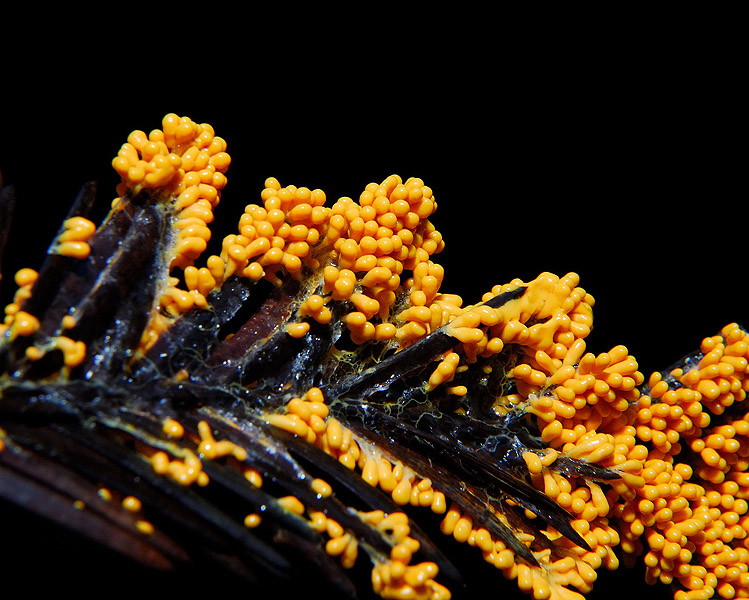
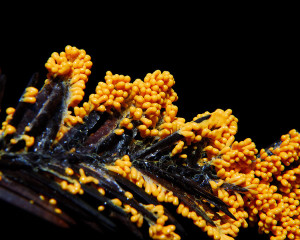
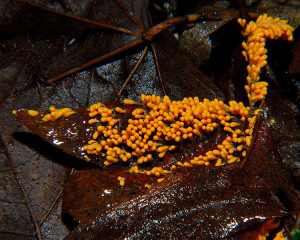


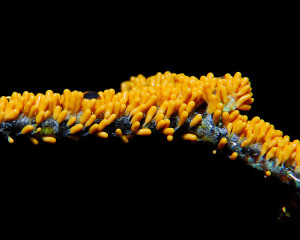
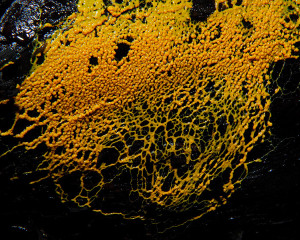

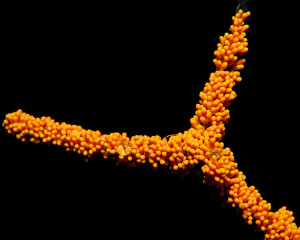
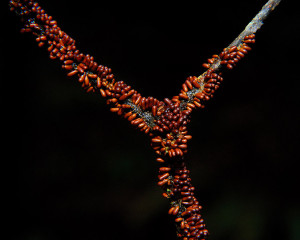
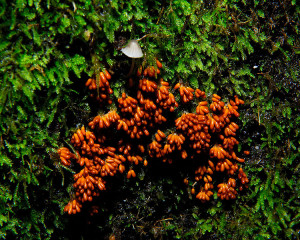







I always find your posts fascinating – just like the slime molds.
Wow, slime molds will take over the world… for 24 hours or so. The second photo is in the shape of a swan- are they trying to communicate with us? Awesome photos, as usual!
Wow… I had no idea. I saw a teeny patch of their fruiting bodies on some deadwood this summer after a few heavy rains and just assumed it was a weird kind of mushroom. It was nothing like these quantities you’ve photographed, though. Fascinating post!
What an extraordinary post!! I love the video… the assortment of life and the checks and balances are incredible in our world. The diversity and mystery beyond true comprehension… though the effort is forever underway.
Very interesting post, slime mold could come from another planet. That video is amazing. Look forward to reading your future posts.
The vivid colour is amazing! Thanks for a very informative and interesting post. If these are found worldwide I will have to dash to our nearby forests to see if any appear after rain.
The look like golden strands of DNA in some of your photos. Fascinating Nature things. 🙂
That’s funny Christine, I hadn’t noticed the ‘swan’ shape in that one photograph until you brought it up.
Heidi, you’re quite right, the color is quite stunning. It really does grab your attention walking through the dark shade in the woods and suddenly seeing a large swath of neon orange. It’s very unexpected!
I thought the video was interesting too, especially watching the transformation from the plasmodial to fruiting body stage. That’s not very easy to just describe in words.
Thank you for this post… I don’t know this Leocarpus fragilis, but a few years ago, I found another slime mold in my garden, Fuligo septica, which is called ‘Heksenboter‘ (witches’ butter), but in english has the less palatable name ‘dog’s vomit slime mold’.
I must admit ‘your’ slime mold is much more photogenic than mine…
Dear Curbstone Valley, This is so extraordinary and so very, very interesting. You have made a subject, about which I confess I knew practically nothing, both informative and captivating. As others have remarked, your photography is outstanding.
One of the joys to me of Blotanical, in addition to ‘meeting’ such delightful people, is to learn so many new things; your posting has proved to be no exception.
Thank you for the comment left on my site to which I have replied.
Great post. Incredibly fascinating. I had learned of slime molds in some class or another and had seen one hiking once, but this post brought them to life.
Just toured your blog and am awed by the extent of the project that you’ve taken on. Love “Wally” the chipper, using an auger to plant bulbs, and the protection you’ve given your Buff Orpington hens. I hope you’ll show more long-range photos of your garden and orchard so we can “see” it better as it progresses.
I’m so glad everyone has enjoyed this post…slime mold isn’t exactly an exotic subject 😛
Lou, thank you for rummaging through old posts too. ‘Wally’ has been put to very good use, and I don’t know how we survived without it!
As the rains seem to have subsided a bit for now, we should have some updates on the orchard planting and veggie gardens very soon!